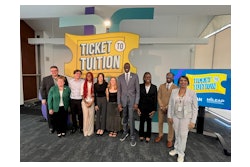A recently released study titled, “STEM Summer Programs for Underrepresented Youth Increase STEM Degrees,” notes that Black and Latinx students who participated in a rigorous STEM summer program prior to their senior year of high school were more likely to enroll at top-ranked colleges and universities, persist and graduate within four years with a STEM degree.
Released by the National Bureau of Economic Research, the study indicates that the STEM pipeline is better strengthened by the earlier intervention rather than the conventional practice of providing supports to students already enrolled in colleges or universities.
Dr. Sarah Cohodes, an associate professor of economics and education at Teachers College, Columbia University, said she and her co-authors wanted to take this exploration from anecdotal evidence—individuals saying such programs made a difference in their lives—to something formal to support the idea. The objective is to show the programming made an impact rather than the assumption that these were highly motivated students who would have succeeded regardless. Dr. Sarah Cohodes
Dr. Sarah Cohodes
“Information like this is what helps make policy decisions about what kind of programs to invest in and where it is important to support different initiatives,” said Cohodes.
The researchers found a host institution that ran summer programs and the data was collected from high-achieving, rising high school seniors enrolled over three summers starting in 2014. Each summer, 75–120 students were randomly assigned to one of three learning groups. One group participated in a six-week residential program; one group attended a one-week compressed residential program and one group took part in an online cohort. There was also a control group. Researchers then compared enrollment trends, persistence and graduation rates.
While 87% of the individuals in the control attended a four-year college immediately after high school, by the fourth year of college the number dropped to 75%. Of the control group students, 53.2% graduate from a four-year college in four years, which is higher than the national four-year graduation rate of 45.3%, but researchers found this low because these students have near-perfect GPAs. By contrast, those students from the control group who attended the institution that hosted the summer programs had a four-year graduation rate of 87%.
The STEM summer programs increased the four-year graduation rate. Both the six-week and one-week programs increase the likelihood that a student graduates from any institution within four years by about 8 percentage points.
Not only did the programs impact persistence and graduation, but it also impacted where the students attended college or university. Students who participated in programs applied to and attended more elite institutions than those in the control group.
“Once we had outcomes, it became very clear that where you go to college matters a lot and programs that change where you go to college can have a huge difference in people’s lives,” said Cohodes. “Programs like the one we studied helped students get into colleges that have high graduation rates, that are resource-intensive and that have strong STEM programs.”
One of the report’s co-authors, Dr. Silvia Robles, a researcher at Mathematica, attended such a program as a high school student and said it had a huge influence on her sticking with STEM. Growing up in Arizona, she planned to apply only to the University of Arizona and Harvard University. Attending the summer program, she learned about many institutions, and she wound up doing her undergraduate studies at MIT, earning a degree in mathematics and economics.
“These really important decisions were highly influenced by this very short duration of time in my life. I thought, could this be the case more broadly? Is this happening on average to students who go through these types of programs?” said Robles, who launched this study when she was in graduate school.
“I hope that people will realize that there are pivotal moments when people are making decisions that are very influential to what happens down the line, and one of those is when you’re applying to college,” said Robles.
There are many students from underrepresented backgrounds who are interested in STEM fields, but Cohodes noted that those interested in increasing diversity in STEM have to meet those students with supports in order to push that interest forward. Researchers noted that people who graduate with STEM degrees will earn more.
Cost of the programs varies. The six-week program costs approximately $15,000 per student versus approximately $2,000 per student for the one-week and online programs. There are more applicants than there are spots.
Colleges and universities are more likely to fund programs for students who are already enrolled, said Cohodes, who added that she would like to see more federal funding for programs for high school students such as these because the benefits are societal.
“These students who go to the resource-intensive colleges, it is really changing their trajectory,” said Cohodes. “What makes a difference with these high school programs is they push you to these schools that are equipped to really support students.”
Robles agrees, noting either more students should be directed to more highly resourced institutions or more resources need to be allocated to other institutions.
“[Something] that needs a lot more research is the effect of resources,” Robles said. “All of these universities at the elite levels have so much more resources per student. Sometimes, when you’re a student who’s at risk of falling through the cracks it does matter.”


















